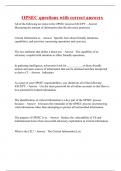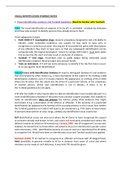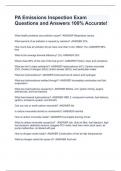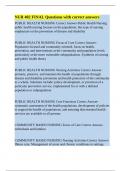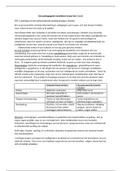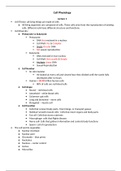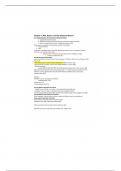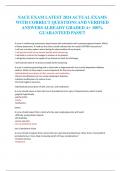Summary of all theories + important figures/models – Understanding Prejudice
Theory + Founder Core Concepts What leads to prejudice? Measures
Social Identity Theory (SIT) - Social categorization = process of bringing - Group formation leads to - Minimal group
Henri Tajfel (1960s-1970s) together social objects in groups which are discriminatory behavior. experiment (dot
relevant to the individual. - Positive behavior of an estimation,
- Social identity = the realization that one individual outgroup rewarding,
belongs to a social category and the positive member does not identifying
or negative evaluation associated with this generalize, but negative strategies)
membership (culturally and context behavior does.
dependent). - Becoming aware of dual
- Social comparison = people try to evaluate identification of the
their group’s relative status by social outgroup members can
comparison. People strive to belong to a improve intergroup
positively evaluated group. relations.
- Psychological group distinctiveness = need
for belonging to a positively evaluated group
but also need to be distinct from others.
People try to achieve a position that is
distinct and positive.
- Outgroup homogeneity = people from a
group generalize their attitudes towards the
entire outgroup.
- Distinctiveness threat = when a group’s
identity is being eroded, the ingroup identity
is no longer meaningfully and positively
distinct from relevant outgroups. Leads to
rejection, dislike and aggression.
- Other-race effect = when individuality of a
person from an outgroup isn’t seen, group
stereotypes are more powerful.
, - Positive-negative asymmetry = consistent
evidence only for positive discrimination but
not negative discrimination.
Realistic Group Conflict - In-group favoritism = ‘we’ against ‘them’. - Allport: prejudiced - Robbers Cave
Theory (RGCT) Group competition leads to stronger in-group personality is ego- Experiment:
Muzafer Sherif (1950s) solidarity and out-group hostility. alienated, longs for intergroup conflict
- Out-group derogation = outgroup definitiveness, safety and occurs when two
homogeneity. authority. groups compete for
- Zero-sum fate = groups (perceive to) - Adorno: the authoritarian limited resources.
compete for limited resources: conflict personality is obedient to - Shared objectives
develops if one group wants something that authority and supports and collaborative
another group already has. social hierarchies, efforts help reduce
- Realistic conflicts = a particular object wants conforms to dominant conflict.
to be achieved; aggression is directed at the social norms, suspicious
competitor for that object and there are and hostile.
functional alternatives to the means. - Blumer: prejudice is
- Nonrealistic conflicts = aggression is the fundamentally a matter of
means to the object people want to achieve; relationship between racial
aggression is not directed at anyone in groups.
particular; there are functional alternatives to - Prejudice develops when a
the object. group’s position is being
- Scapegoat theory = often a mix of threatened.
nonrealistic and realistic conflicts is at play
when groups compete over scarce resources.
- Thomas theorem = if men define situations
as real, they are real in their consequences;
related to perceived or real competition.
Intergroup Threat Theory - Realistic threats = threat to the very - Prejudice develops when -
(ITT) existence. Consists of 1) individual threats = members of one group
Renfro & Stephan (2002) physical or material harm to an individual, perceive that the other
and 2) group threats = to a group’s power, group is in a position to
resources and general welfare. cause them harm.
, - Symbolic threats = different morals, values
and standards. Consists of 1) individual
threats = loss of face or honor and the
undermining of an individual’s self-identity
or self-esteem, and 2) group threats = to a
group’s religion, values, belief system, etc.
Contact Hypothesis - Friendship potential = addition from - Not all types of contact - Allport measured
Allport (1954) Pettigrew (1998) when the first three of reduce prejudice. stereotypes by
Allport’s conditions are met; the longer the - Contact reduces prejudice proximity to a
contact, the stronger effect. It has become an if four conditions are met: segregated black
important empirical indicator of contact. 1) Equal status; 2) neighborhood.
- Causality problem = contact is correlated Common goal; 3) Concluding that the
with less prejudice, because contact reduces Intergroup cooperation; 4) reason for prejudice
prejudice. Because prejudiced individuals try Support from authorities, varies with
to avoid contact and people with positive law or custom. proximity.
attitudes seek out contact (selection bias). - Contact increases - Experiments and
knowledge and thus forced contact
disconfirms negative
stereotypes; contact should
be more effective in
reducing cognitive
prejudice (stereotypes) than
affective prejudice
(disliking).
Contact Theory - Extended contact = knowing someone from - Contact reduces/prevents - Longitudinal
your group is having contact with outgroup threat to the ingroup. research where liking
members. Contact can thus counter and prejudice are
- Imagined contact = imagining a positive realistic group conflict. measured over time
situation with an outgroup member, reduces - Contact is only effective if (Stark et al., 2013).
prejudice. it generalizes to the - Since the meta-
- Vicarious contact = via reading about outgroup as a whole and to analysis of Pettigrew
positive contact. other situations than the and Tropp (2006)
, - Parasocial contact = media reporting positive one where the contact took there is also research
contact with outgroup members. place. on negative effects of
- Secondary transfer effect = the generalization - Positive indirect contact contact.
of contact effects from encountered outgroup also reduces prejudice. - Proximity is NOT the
to other outgroups. This is also present with same as contact!
indirect contact (e.g., parasocial contact).
Deductive-nomological - Law/general proposition = base of the theory - -
model or a regularity, which was found repeatedly
(t y)
- Specific condition = specific situation for
which we expect the law to apply (x is part
of t)
- Explanandum = derived hypothesis / new
prediction (x y)
- Syllogism = drawing a conclusion based on
an explanas (law and condition) and an
explanandum
Right-Wing - The authoritarian personality = a particular - RWAs believe some people - The F-scale = items
Authoritarianism (RWA) personality type is more likely to obey are meant to dominate and are measured on
Adorno, Sanford, Frenkel- authorities. (social identities differ per others should follow the agree-disagree scale.
Brunswik, Levinson (1950s) context, while personality types are stable rules (traditional There are spuriously
Bob Altemeyer (1980s) tendencies throughout the lifespan). This conventions). high correlations
personality type is more conventionalist, - Prejudice occurs because between items.
conformist, suspicious and hostile and status they see the world as a People tend to agree
oriented; prone to be highly prejudiced. dangerous place where with any statement
- RWA = 1) blind loyalty to established traditional conventions are and low education
religious and political authorities, 2) a crumbling. Also the feeling and SES score high.
willingness to act aggressively in order to that minorities are a threat - The Milgram
defend those authorities, 3) a deep sense of to a group’s sense of safety Experiment: student,
conventionalism. Learned via socialization. and their traditional teacher,
People with high RWA are self-righteous conventions. experimenter.
(more moral and upstanding), are rightwing - !: RWA does not correlate Problem: not only






